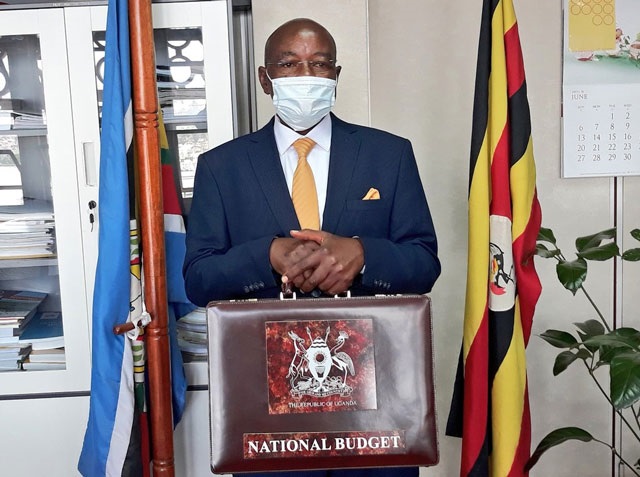
Experts speak on 2023/24 allocations, taxes, borrowing
COVER STORY | ISAAC KHISA | The government’s plan to spend more money next financial year which it hopes mainly to borrow because it cannot raise it otherwise, has led to accusations that “it is playing politics with the budget”.
“Our government should not seek political mileage out of economic decisions,” said Jane Nalunga, the executive director at the Southern and Eastern Africa Trade, Information and Negotiations Institute (SEATINI), soon after parliament passed the government’s revenue and expenditure budget on May 18.
“This budget won’t take us anywhere,” she said.
Nalunga said the government continues to make the mistake of increasing the budget on an annual basis coupled with low revenue collections.
“In this scenario, we are going to either continue to borrow or seek aid to implement our proposed budget sinking deeper into a debt trap,” she said.
The Leader of the Opposition in Parliament, Mathias Mpuuga equally lamented the manner in which the government’s borrowing to fund its budget has been increasing over the years.
“This has undermined the private sector whereby the acquisition of credit has become expensive,” Mpuuga tweeted on May 18.
Although government officials rallied to defend the proposed borrowing, saying it was necessary for infrastructure and other development projects, their case appeared weakened because of the lack of clarity on the sector allocations.
Unlike in past years, Parliament this time passed the budget without clear revenue allocations to different Ministries, Agencies, and departments. It was a fumble up to the last minute with the Speaker of Parliament, Anita Among, telling the plenary on May 16 that the budget allocation process had been hijacked by mercenaries.
“There are mercenaries (in the Budget Committee) advocating for particular entities. They are the people disorganising the Committee,” Among told Parliament and threatened to oversee the process herself.
The allocations will hopefully become known when the budget is read on June 15.
Spending more without earning
The government plans to spend Shs52.7 trillion next financial year which is Shs4.6 trillion or 10% more than it proposed to spend this financial year.
This indicates a Shs 4.6 trillion increase in the budget from the current Shs 48.1 trillion. The government plans to finance the national budget through domestic revenue mobilisation equivalent to just Shs29 trillion or 55% of the budget.
The government expects to get the rest of the budgeted money from budget support (donors) amounting to Shs2.5 trillion, domestic borrowing Shs1.58 trillion and external project support worth Shs 8.04 trillion. This is money tied to specific projects by donors. Another Shs8.798 trillion will go to domestic refinancing which means the government will replacing the existing debt by more borrowing.
The original National Budget Framework Paper for 2023/24 indicates that though the national budget is set to increase, discretionary expenditures which is money that can be spent by different sectors is to reduce by Shs 2.5 trillion due to the increase in the budget for interest and debt payment. The money the government needs to pay debts has risen from Shs16 trillion to Shs19 trillion.
This development comes as a Bank of Uganda report shows that the government has in this financial year failed to raise enough money to fund its budget. The BoU report shows that for the nine months of FY22/23 the government expenditure fell short by 9%. The government managed to spend Shs.25 trillion compared to the projected Shs.27 trillion.
BoU says the government failed to raise money as it had hoped from grants and tax revenues leading to a Shs17 trillion shortfall. It said government revenues undershot the target by 2.5%. It said grants failed by Shs882.1 billion against a Shs.1.8 trillion. Tax revenues suffered mainly due to indirect or consumption taxes.
BoU said Uganda’s external position, which is an indicator of the sustainability of its external debt, remained “fragile” in the 12 months to March 2023. BoU blamed exogenous factors and high external debt service obligations.
BoU says the current account deficit at US$ 3,851.3 million remains high and elevated by historical standards. The current account records the country’s international transactions.
“Overall, a BOP deficit of US$ 1,069.2 million was registered in the year to March 2023, a reversal from a BOP surplus of US$ 738.5 million recorded in the previous year,” BoU says in its executive summary.
“Financing of the current account was mainly from foreign direct investment and drawdown on international reserves.” Uganda’s estimated stock of reserves at the end of March 2023 was US$3,628.8 million, lower than US$4,463.6bmillion at the end of March 2022. That is a 20% drop in one year.
Last month, BoU maintained the Central Bank Rate (CBR) at 10% in a bid to deliver inflation back to the 5% target by the end of this year. Consistent with the Monetary policy actions, liquidity conditions have remained tight forcing interest rates to edge up and private sector credit to moderate.
Consequently, the money market rates have trended very close to the upper band of the central bank rate and the shilling lending rate increased by 41 basis points to an average of 19.2% in the three months to March 2023.
This development slowed the uptake of private sector credit growth to 9.8 % in the three months to March 2023 from 10.2% in the three months to December 2022.
Unclear allocations
The 2023/24 budget promises full monetisation of the economy through commercial agriculture, industrialization, expanding and broadening services, digital transformation and market access.
However, it remains unclear how the funds, whose budget has been revised upwards by 10% will be allocated.
The original National Budget Framework Paper for 2023/24 indicates that the government’s key priorities include the construction of the Standard Gauge Railway and finalisation of the rehabilitation of the Meter Gauge Railway under the Integrated Transport programme whose budget is estimated at more than Shs 4.65 trillion; investing in small-scale solar-powered irrigation as well as addressing climate change and food security under Agro Industrialization Programme whose budget has been estimated at Shs 1.499 trillion.
The other priorities are the construction of power service stations and transmission lines under the Sustainable Energy Development programme whose budget has been estimated at Shs 1.2 trillion and capitalization of Uganda Development Bank and Uganda Development Corporation to continue supporting private sector development, recovery and economic transformation under the Private Sector Development (Shs 1.798 trillion).
Human Capital Development program which includes Education, Health, Gender and Social Development has been planned to receive Shs 9 trillion, an allocation lower than that of 9.089 trillion in the current financial year budget of 2022/2023. While it remains the highest funded programme in the budget, the proposed allocation implies an overall reduction of Shs 83.94 billion.
On the other hand, governance and security programme is proposed to receive Shs 6.8 trillion, lower than the current financial year budget of Shs 7.2 trillion. The sector is composed of different government entities responsible for ensuring security, maintenance of law and order, public policy governance, accountability, administration of Justice and others.

The Integrated Transport Infrastructure and Services is proposed to receive Shs 4.65 trillion up from the Shs 4.3 trillion allocated in the current financial year.
The other programmes are Energy and Mineral Development Sector which will receive Shs 1.8 trillion, Private Sector Development Programme Shs 1.79 trillion, manufacturing Shs 268.4 billion, tourism Shs 89.3 billion and Digital Transformation Programme Shs 176.7 billion.
Tax proposals
The government has come up with numerous tax measures including those that touch on essential commodities. The Value Added Tax (Amendment) Bill, 2023 imposes an 18% tax on diapers. Bottled water will attract a Shs 75 tax on every litre based on the amended Excise Duty Act.
The government has also proposed a 5% tax on online advertising, cloud computing, online gaming, and downloading digital content. Also, the government plans to increase tax on gaming activities from 20% to 30% of the total amount of money staked, less the payouts (winnings) for the period of filing returns for the gaming activity.
Concerning traffic offences, the government has proposed to slap a fine of Shs100,000 for overlapping, driving without a valid license, blocking or parking in spaces such as bicycle lanes, blocking Zebra crossing and driving beyond the prescribed speed limit. Drivers apprehended for speeding will be coughing a whopping fine of Shs2 million. The government also plans a fine of Shs300,000 for driving under the influence of alcohol.
The government has also proposed that a taxpayer who has generated a loss for five years may only deduct 50% of the assessed tax loss carried forward at the beginning of the following tax year and in the subsequent tax years.
This, in essence, assumes that most businesses should have a payback period of five years within which they could recover their initial investment.
However, tax experts argue that this is not true for all businesses as some companies may take many years before turning a profit, because of the heavy investments in the first years.
Unchanged taxes
The government has left some taxes unchanged. Consumers will continue to pay 12% or UGX 250 per litre, whichever is higher as a tax on fruit juice and vegetable juice except juice made from at least 30% pulp or at least 30% juice by weight or volume of the total composition of the drink from fruits and vegetables locally grown.
Un-denatured spirits – that is spirits that are not mixed with any substance that would render the spirit unfit for human consumption or capable of being rendered unfit for human consumption – made from locally produced raw materials will continue to attract 60% or Shs 1,500 per litre, whichever is higher. Similarly, tax on un-denatured spirits made from imported raw materials remains at 100% or Shs 2,500/= per litre, whichever is higher.
Fermented beverages including cider, perry, mead or near beer produced from locally grown or produced raw materials will attract 30% or Shs 550 per litre, whichever is higher as tax to the government.
However, tax on opaque beers has been reduced from 20% or Shs 230 per litre whichever is higher to Shs 12% or Shs 150 per litre whichever is higher starting next financial year, a move seen as the government’s attempt to revive the opaque beer market segment.
This could be a relief to a section of prospective investors in opaque beer brands such as Nile Breweries Ltd which had shut down its Shs 14 billion opaque beer plant in Jinja in 2018 – barely a year into operation.
The government had in 2018 imposed a 30% or Shs 650 per litre as a tax on the Chibuku beer brand, equivalent to a traditionally-made brew known as Malwa, Ajono or Kwete.
But Nile Breweries Ltd executives argued that the move made Chibuku unsustainable because it was not meant to compete with clear beer, but against illicit traditional brews and sachet spirits that do not pay taxes.
Chibuku was priced at Shs 1,000 per 500ml bottle to make it competitive with the local brews and spirits that sold for an average Shs 800.
The incoming international calls, except calls from the Republic of Kenya, the Republic of Rwanda and the Republic of South Sudan will also continue to attract a US$ 0.09 per minute as tax.
Budget critics
Jane Nalunga, the executive director at the Southern and Eastern Africa Trade, Information and Negotiations Institute (SEATINI) told The Independent that the budget does not address the challenges facing the country such as debt, unemployment and economic crisis.
“We need to rethink the ideology underpinning the budget and come up with a clear way forward,” she said.
She said the government needs to re-assess its resource allocation such that more resources are put into productive sectors such as agriculture, minerals and tourism among others.
She said the Parish Development Model is a good idea but it will simply distribute some money to the people that would end up using it for drinking.
“Will it help overhaul the economy?” she said. She said Uganda needs to be negotiating the African Continental Free Trade Area, the African Growth and Opportunity Act (AGOA) and many more seeking market opportunities.
“Now will PDM help us achieve that?” she said, “We are not serious at all and we shall continue to be in the debt crisis.”
National budgets across East Africa
Elsewhere across the East African region, Kenya, Tanzania and Rwanda have also increased their proposed national budget for the next financial year though with a lower margin.
Kenya’s treasury has proposed a 7% increase in the national budget to Kshs 3.64 trillion for the new financial year that starts on July 1, 2023. The Kenyan government plans to cut borrowing and rely more on domestic revenue mobilisation.
As a result, the government has proposed to double the VAT on fuel from the current 8% to 16%, a heavier beauty tax on items like wigs and false beards and a 3% housing levy on workers’ gross monthly salaries.
Kenya’s President Dr. William Ruto, who has been in office since September last year, has prioritised increased revenue collection on his agenda to make the country less reliant on external debt, stabilise an economy he says he inherited in a bad state from the previous administration of former president Uhuru Kenyatta and fund social programmes such as affordable housing.
Dr. Ruto’s administration has in past also increased contributions to the state pension scheme up to tenfold as part of efforts to strengthen the country’s social security system and promote a savings culture.
However, tax experts at Ernst & Young (EY) Partner and Tax Leader, Francis Kamau noted last month that the government has been focusing on increasing taxes each year hurting business growth and this has not resulted in higher revenue.
He said the government should focus on expanding the tax base instead by driving the growth of key sectors in the economy such as agriculture and manufacturing, while also netting the informal sector and high net worth individuals.
Tanzania, too, has proposed to increase the national budget by 7% to Tshs44.3 trillion for the next financial year, with the country’s proposed development budget expected to increase by 1% to Tshs 15.15 trillion. Recurrent expenditure is expected to increase by 10% to Tshs 29.2 trillion.
The Rwandan government has planned to spend slightly over Rwf5 trillion in the FY 2023/24, which represents an increase of 6% or Rwf265 billion compared to Rwf 4.7 trillion for the current financial year that ends on June.30.
Rwanda hopes to spend Rwf 1,991 billion on development budget and policy lending while the recurrent budget is estimated at Rwf 2910 billion, accounting for 58 % of the total budget.
Trend of proposed budget over the past Five Financial Years
| FY | 2019/2020 | 2020/21 | 2021/2022 | 2022/23 | 2023/24 |
| Budget (trillions) | 40.5 | 45.5 | 44.7 | 48.1 | 52.7 |
New proposed taxes
| No. | Current item description | Proposed item description | Current duty rate | Proposed duty rate |
| 2 (d) | Opaque Beer | Opaque Beer | 20% or Shs 230 per litre, whichever is higher | 12% or Shs150 per litre, whichever is higher |
| 3 (a) | Un-denatured spirits made from locally produced raw materials. | Un-denatured spirits, of alcoholic strength
by volume of 80% or more made from locally produced raw materials |
60% or Shs 1,500 per litre, whichever is higher | 60% or Shs1,500 per litre, whichever is higher |
| 3 (b) | Un-denatured spirits made from imported raw materials | Un-denatured spirits, of alcoholic strength by volume of 80% or more made from imported raw materials | 100% or Shs 2,500 per litre, whichever is higher | 100% or Shs 2,500 per litre, whichever is higher |
| 3 (c) | Ready to drink spirits | any other un-denatured spirits that are either —
(i) locally produced and less than 80% alcohol by volume |
Nil | 80% or Shs 1,700 per litre, whichever is
higher |
| (ii) imported and less than 80% alcohol by volume | Nil | 100% or Shs 2,500per litre, whichever is higher | ||
| 3 (d) | Un-denatured spirits made from locally produced raw materials used in the production of disinfectants and sanitizers for the prevention of the spread of COVID-19, with an alcoholic content by volume not less than 70% | Un-denatured spirits made from locally produced raw materials used in the production of disinfectants and sanitizers for the prevention of the spread of COVID-19, with an alcoholic content by volume not less than 70% | Nil | Nil |
| 5 (b) | Fruit juice and vegetable juice (except juice made from at least 30% pulp or at least 30% juice by weight or volume of the total composition of the drink from fruits and vegetables locally grown) | Fruit juice and vegetable juice, (except juice made from at least 30% pulp or at least 30% juice by weight or volume of the total composition of the drink from fruits and vegetables locally grown) | 12% or Shs 250 per litre, whichever is higher | 12% or Shs 250 per litre, whichever is higher |
| 5 (d) | Any other non-alcoholic beverage locally produced other than the beverage referred to in paragraph (a) made out of fermented sugary tea solution with a combination of yeast and bacteria | Any other non-alcoholic beverage locally produced other than a beverage referred to in paragraph (a) made out of fermented sugary tea solution with a combination of yeast and bacteria | 12% or Shs 250 per litre, whichever is higher | 12% or Shs150 per litre, whichever is higher |
| 13 (g) | Incoming international calls, except calls from the Republic of Kenya, the Republic of Rwanda and the Republic of South Sudan | Incoming international calls, except calls from the Republic of Kenya, the United Republic of Tanzania, the Republic of Rwanda and the Republic of South Sudan | USD 0.09 per minute | USD 0.09 per minute |
| 25
(b) |
Any other fermented beverages including cider, perry, mead or near beer produced from locally grown or produced raw materials | Any other fermented beverages including cider, perry, mead or near beer produced from locally grown or locally produced raw materials | 30% or Shs 550 per litre, whichever is
Higher |
30% or Shs 550 per litre, whichever is
higher |
| 26 | Construction materials of a manufacturer, other than a manufacturer referred to in item 21, whose investment capital is, at least USD 35m in case of a foreigner or USD 5m in the case of a citizen | Construction materials of a manufacturer, other than a manufacturer referred to in item 21, whose investment capital is at least USD 35m in the case of a foreigner or USD 5m in the case of a citizen | Nil | Nil |
 The Independent Uganda: You get the Truth we Pay the Price
The Independent Uganda: You get the Truth we Pay the Price


